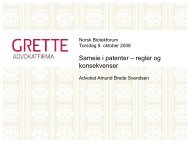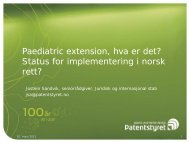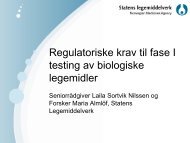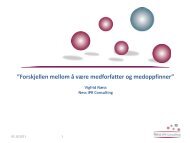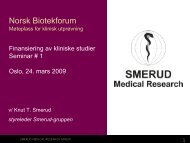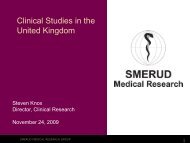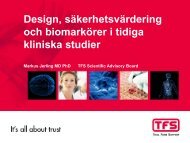Challenges and opportunities in development of efficious fish ...
Challenges and opportunities in development of efficious fish ...
Challenges and opportunities in development of efficious fish ...
Create successful ePaper yourself
Turn your PDF publications into a flip-book with our unique Google optimized e-Paper software.
<strong>Challenges</strong> <strong>and</strong> <strong>opportunities</strong> <strong>in</strong><br />
<strong>development</strong> <strong>of</strong> <strong>efficious</strong> <strong>fish</strong> vacc<strong>in</strong>es<br />
Edel Anne Norderhus<br />
Director Product Development R&D<br />
PHARMAQ
PHARMAQ`s bus<strong>in</strong>ess idea<br />
• We provide environmentally sound,<br />
safe <strong>and</strong> efficacious health products to<br />
the global aquaculture <strong>in</strong>dustry through<br />
targeted research <strong>and</strong> the commitment<br />
<strong>of</strong> dedicated people<br />
2
PHARMAQ company<br />
PHARMAQ company<br />
• Head <strong>of</strong>fice <strong>in</strong> Norway, subsidiaries <strong>in</strong> the UK, Chile, Turkey <strong>and</strong><br />
Vietnam<br />
• Numbers <strong>of</strong> employees per September 141 persons<br />
• Global market share <strong>in</strong> salmonids more than 50 %. Ma<strong>in</strong> competitor<br />
Novartis <strong>and</strong> Intervet Sher<strong>in</strong>g Plough<br />
• Approximately NOK 80 mill allocated to R&D <strong>in</strong> 2011
Contents Agenda<br />
• General <strong>in</strong>formation<br />
about <strong>fish</strong> vacc<strong>in</strong>es<br />
• <strong>Challenges</strong> for <strong>fish</strong><br />
vacc<strong>in</strong>e <strong>development</strong><br />
- Cost-effective vacc<strong>in</strong>e<br />
- Long-last<strong>in</strong>g protection<br />
- Safe<br />
- Authorities requirement to<br />
documentation<br />
- New technology
Pathogens <strong>in</strong> licensed vacc<strong>in</strong>es<br />
Type<br />
Bacteria<br />
Intracellular<br />
bacteria<br />
Species<br />
Aeromonas salmonicida,<br />
Listonella (Vibrio) anguillarum O1 & O2<br />
Photobacterium damsela subsp. piscicida,<br />
Moritella viscosa,<br />
Vibrio salmonicida.<br />
Vibrio ordalii<br />
Yers<strong>in</strong>ia ruckeri<br />
Streptococcus <strong>in</strong>iae<br />
Streptococcus agalactiae<br />
Edwardsiella ictaluri<br />
Edwardsiella tarda<br />
Lactococcus garvieae<br />
Flavobacterium phsycrophilium<br />
Piscirickettsia salmonis<br />
Francisella sp<br />
Virus<br />
Infectious pancreatic necrosis virus (IPNV)<br />
Infectious salmon anemia virus (ISAV)<br />
Pancreas disease virus (PDV)<br />
Infectious Heamtopoietic Necrosis Virus (IHNV)
Geographical areas where vacc<strong>in</strong>ation are<br />
common practice<br />
Vacc<strong>in</strong>es are available ma<strong>in</strong>ly where aquaculture is commerzilisedareas
Different types <strong>of</strong> vacc<strong>in</strong>es <strong>in</strong> Norway 1987-2003<br />
30,000<br />
180,000<br />
Immersion vacc<strong>in</strong>e liters<br />
25,000<br />
20,000<br />
15,000<br />
10,000<br />
5,000<br />
160,000<br />
140,000<br />
120,000<br />
100,000<br />
80,000<br />
60,000<br />
40,000<br />
20,000<br />
Injection vacc<strong>in</strong>e doses<br />
immersion (liters)<br />
oil-based <strong>in</strong>jection<br />
water-based <strong>in</strong>jection<br />
0,000<br />
0,000<br />
1985<br />
1987<br />
1989<br />
1991<br />
1993<br />
1995<br />
1997<br />
1999<br />
2001<br />
2003<br />
Sommerset et al. Expert Rev Vacc<strong>in</strong>es 2005;4:89-101
<strong>Challenges</strong> <strong>in</strong> <strong>fish</strong> vacc<strong>in</strong>e <strong>development</strong><br />
• Low cost<br />
• Efficacious<br />
– Long-last<strong>in</strong>g protection<br />
– Multivalent: Efficacious towards several<br />
diseases<br />
• Safe<br />
– Low side effect levels (<strong>in</strong>activated)<br />
– Not revert to virulence (live)<br />
– GMO (live <strong>and</strong> DNA vacc<strong>in</strong>es)
Fish health represents a small portion <strong>of</strong> total farm<strong>in</strong>g cost<br />
- but will<strong>in</strong>gness to spend more when needed (e.g. lice, PD)<br />
Cost structure <strong>in</strong> the Norwegian salmon farm<strong>in</strong>g <strong>in</strong>dustry<br />
NOK/kg 2006 2007 2008 2009 2010e 2011e<br />
Smolt 1,76 2,36 2,33 2,16 2,16 2,16<br />
Feed 9,29 10,08 10,85 10,94 11,24 11,34<br />
Insurance 0,18 0,17 0,17 0,15 0,15 0,15<br />
Salaries 1,59 1,54 1,59 1,43 1,43 1,43<br />
Depreciation 0,82 0,93 1,18 1,10 1,10 1,10<br />
Other operat<strong>in</strong>g cost * 2,48 2,12 3,20 3,22 3,52 3,62<br />
Net f<strong>in</strong>ance 0,26 0,48 1,04 0,42 0,42 0,42<br />
Production cost 16,37 17,68 20,34 19,42 20,02 20,22<br />
Slaughter 2,32 2,50 2,59 2,61 2,61 2,61<br />
Total cost 18,69 20,18 22,93 22,03 22,63 22,83<br />
* Where<strong>of</strong><br />
Vacc<strong>in</strong>es ** 0,20 0,17 0,19 0,29 0,33 0,32<br />
% <strong>of</strong> total cost 1,1 % 0,8 % 0,8 % 1,3 % 1,5 % 1,4 %<br />
Sea lice treatment ** 0,76 0,79 0,81<br />
% <strong>of</strong> total cost 3,4 % 3,5 % 3,5 %<br />
** Rough estimates based on statements from <strong>in</strong>dustry players <strong>and</strong> must not be considered accurate<br />
Source: Norwegian Directorate <strong>of</strong> Fisheries, FishPool, Kverva Research<br />
9
From idea to licensed product<br />
Identification - process <strong>development</strong> – production –<br />
validation – documentation - License
Development <strong>of</strong> a process for a new virus<br />
• How to achieve high yield ... with<strong>in</strong> a limit time<br />
<strong>and</strong> have a reproducible process<br />
Cost effective product<br />
CHALLENGES :<br />
• Select <strong>of</strong> cell l<strong>in</strong>e<br />
• Achieve a high yield<br />
• Choose the right technology<br />
to culture the virus<br />
• Possible to up-scale<br />
Cell<br />
Replication
Water <strong>in</strong> oil emulsion<br />
• Water <strong>in</strong> oil is a on the most efficient vacc<strong>in</strong>e formulations<br />
for ensur<strong>in</strong>g long term protection by a s<strong>in</strong>gle <strong>in</strong>jection.<br />
• Factor contribut<strong>in</strong>g to efficacy<br />
• .<br />
– 1) Depot: Retention <strong>and</strong> slow release <strong>of</strong> antigen<br />
– 2) Presentation: Uptake <strong>of</strong> vacc<strong>in</strong>e droplets by APCs<br />
– 3) Immunostimulation: Bacteria conta<strong>in</strong> immunostimulatory<br />
compounds such as lipopolysaccharides, peptidoglycan <strong>and</strong><br />
procaryotic DNA motifs.
Vacc<strong>in</strong>e adm<strong>in</strong>istration<br />
Labour<br />
Efficacy<br />
Oral Bath Immersion Injection<br />
Slide 13<br />
Figures cortesy <strong>of</strong> Ida Skaar
Oral vacc<strong>in</strong>es<br />
• Ideal delivery method (no labour)<br />
• Poor <strong>and</strong> short last<strong>in</strong>g protection<br />
– Exceptions: Yers<strong>in</strong>ia ruckeri <strong>and</strong> Vibrio<br />
anguillarum.<br />
• Gastric degradation can affect<br />
protective antigen<br />
Day 3<br />
Day 1
Adverse reactions<br />
Reactions after oil<br />
based <strong>in</strong>jection <strong>in</strong><br />
salmon <strong>and</strong> sea bass<br />
Photo: Trygve T Poppe.<br />
Adverse reactions are species<br />
dependent<br />
Photo: Thanos Prapas
Extended safety<br />
Fish <strong>in</strong> hold<strong>in</strong>gtank<br />
Individual<br />
vacc<strong>in</strong>ation <strong>in</strong><br />
abdom<strong>in</strong>al cavity<br />
Immunization<br />
sampl<strong>in</strong>g<br />
sampl<strong>in</strong>g<br />
6 weeks 12 weeks<br />
R<strong>and</strong>omly selected<br />
<strong>fish</strong> transfered to<br />
experimental units<br />
Acclimation for m<strong>in</strong><br />
one week:<br />
Temperature 17 o C<br />
water quality,<br />
light..<br />
Adhesions <strong>and</strong> melan<strong>in</strong><br />
evaluation<br />
Weight
Vacc<strong>in</strong>e responses<br />
• Killed vacc<strong>in</strong>es<br />
– Humoral (antibody)<br />
responses<br />
• Live, attenuated <strong>and</strong><br />
DNA vacc<strong>in</strong>es<br />
– Cytotoxic T-cell<br />
response<br />
• New adjuvant systems<br />
aid <strong>in</strong> activat<strong>in</strong>g both<br />
arms <strong>of</strong> the adaptive<br />
immune system<br />
Fusogenic<br />
liposomes<br />
Virosomes<br />
ISCOMs<br />
M<strong>in</strong>eral salts ,<br />
Emulsions<br />
Polymer particles
Fish Vacc<strong>in</strong>es<br />
Past Current Future<br />
Waterbased<br />
Alum<strong>in</strong>ium<br />
Emulsions<br />
DNA<br />
Live Bacterial<br />
What is the<br />
<strong>opportunities</strong> <strong>and</strong><br />
challenges for<br />
future vacc<strong>in</strong>e<br />
technology <strong>in</strong><br />
aquaculture <br />
Live viral<br />
Reverse genetics<br />
PLGA particles, VLPs,<br />
ISCOM, Virosomes,<br />
Liposomes<br />
<br />
1970 1980 1990 2000 2010
DNA vacc<strong>in</strong>es<br />
• Advantages<br />
– presentation by MHC-I<br />
elicits cytotoxic response<br />
as well<br />
– low cost, stable<br />
– multivalent or multigenic<br />
– can be modified to <strong>in</strong>clude<br />
co-stimulatory molecules<br />
• Disadvantages<br />
– delivery by i.m. Injection<br />
– Persistence <strong>of</strong> plasmid DNA <strong>in</strong><br />
muscle<br />
– GMO issues<br />
• Viral epitope<br />
<strong>in</strong>serted <strong>in</strong><br />
plasmid<br />
• Taken up by<br />
host cell –<br />
viral prote<strong>in</strong><br />
antigen<br />
produced <strong>in</strong><br />
host cells<br />
• Mimics<br />
natural<br />
<strong>in</strong>fection<br />
Pol<strong>and</strong> et al. 2002, BMJ 324;1315-1319
Experimental DNA vacc<strong>in</strong>es <strong>in</strong> <strong>fish</strong><br />
Pathogen Viral fam Gene Protection<br />
Infectious Hematopoietic Necrosis Virus (IHNV)<br />
Viral Hemorrhagic Septicemia Virus (VHSV),<br />
Hirame rhabdovirus (HIRRV)<br />
Spr<strong>in</strong>g viremia <strong>of</strong> carp virus (SVCV)<br />
Rhabdoviridae G-gene High<br />
Infectious pancreatic necrosis virus (IPNV)<br />
Birnaviridae<br />
Seg. A large ORF<br />
& VP2<br />
Infectious salmon anemia virus (ISAV)<br />
Orthomyxoviridae<br />
Hemaglut<strong>in</strong><strong>in</strong><br />
esterase HE<br />
Moderate<br />
Red seabream iridovirus (RSIV)<br />
Iridoviridae<br />
Major capsid<br />
prote<strong>in</strong>, ORF569<br />
Channel cat<strong>fish</strong> virus (CCV) Herpesviridae ORF 6&59 No<br />
Atlantic halibut nodavirus (AHNV) Nodaviridae Capsid prote<strong>in</strong> No<br />
Kurath 2008
Live vacc<strong>in</strong>es<br />
• Advantages<br />
– High efficacy (elicits<br />
cytotoxic response)<br />
– Low production cost,<br />
compared to <strong>in</strong>activated<br />
– Can be adm<strong>in</strong>istered by<br />
dip/bath or oral delivery<br />
(natural pathway <strong>of</strong><br />
<strong>in</strong>fection)<br />
• <strong>Challenges</strong><br />
– Safety: Must not revert to<br />
virulence<br />
– Document that vacc<strong>in</strong>e is safe<br />
– The safest vacc<strong>in</strong>es are<br />
produced by use genetic<br />
modification (GMO issues)<br />
Methods <strong>of</strong> attenuation<br />
• Attenuation<br />
by passage<br />
<strong>in</strong> cells.<br />
• Virus lose<br />
virulent<br />
properties by<br />
adapt<strong>in</strong>g to<br />
growth <strong>in</strong> cell<br />
l<strong>in</strong>es (virulent<br />
properties not<br />
selected)<br />
• What is risk<br />
<strong>of</strong> reversion<br />
• Attenuation<br />
by use <strong>of</strong><br />
genetic tools<br />
(reverse<br />
genetics)<br />
• Removal<br />
genes vital<br />
for growth or<br />
virulence is a<br />
safe method<br />
<strong>of</strong> attenuation<br />
• GMO issues
Live attenuated bacterial vacc<strong>in</strong>e<br />
• The first licensed modified live bacterial vacc<strong>in</strong>es<br />
for <strong>fish</strong>. Cat<strong>fish</strong> vacc<strong>in</strong>e for US marked.<br />
– Edw. Ict. AQUAVAC-ESC<br />
– Fla. Col. AQUAVAC-COL<br />
(Intervet Scher<strong>in</strong>g-Plough)<br />
• Live Arthrobacter sp. nov., cross protective<br />
property aga<strong>in</strong>st Renibacterium salmon<strong>in</strong>arum.<br />
For use <strong>in</strong> salmonids by <strong>in</strong>jection<br />
– Renogen®<br />
(NOVARTIS ANIMAL HEALTH CANADA Inc)<br />
Slide 22
Basic requirements for live vacc<strong>in</strong>es<br />
• Conta<strong>in</strong> the necessary antigenic<br />
determ<strong>in</strong>ants to <strong>in</strong>duce protective<br />
immunity<br />
• Possess a high immunogenic potential<br />
• Safe for adm<strong>in</strong>istration without risk <strong>of</strong><br />
cl<strong>in</strong>ical <strong>in</strong>fection <strong>in</strong> the vacc<strong>in</strong>ee<br />
• Safe for humans<br />
• Induce a serological response that<br />
allows differentiation <strong>of</strong> vacc<strong>in</strong>ated<br />
from <strong>in</strong>fected animals<br />
• Stable for long-term storage<br />
• Not to be contra<strong>in</strong>dicated for release <strong>in</strong><br />
the environment<br />
• Traceable <strong>in</strong> the animal population <strong>and</strong><br />
<strong>in</strong> the environment
Effect <strong>of</strong> a live vacc<strong>in</strong>e<br />
120<br />
Cumulative mortality<br />
100<br />
80<br />
60<br />
40<br />
20<br />
Vacc<strong>in</strong>e<br />
shedders<br />
Cumulative mortality<br />
100<br />
80<br />
60<br />
40<br />
20<br />
Test vacc<strong>in</strong>e 1<br />
Test vacc<strong>in</strong>e 2<br />
PBS<br />
Test vacc<strong>in</strong>e 3<br />
AJ 3000<br />
Shedders<br />
Test vacc<strong>in</strong>e 4<br />
0<br />
0 4 8 12 16 20 24 28 32 36 40 44<br />
0<br />
1 3 5 7 9 11 13 15 17 19 21 23 25 27 29 31 33 35 37 39 41<br />
Experiment A. The Vacc<strong>in</strong>e is<br />
based upon new technology<br />
Experiment B. Test vacc<strong>in</strong>e 3 <strong>and</strong> 4<br />
are based upon new technology<br />
Cohabitant challenge model: Natural way <strong>of</strong> <strong>in</strong>fection. 20 %<br />
shedders used. Rather low reproducibility <strong>in</strong> the experiments. The<br />
new vacc<strong>in</strong>e technology always show good protection even the<br />
other test vacc<strong>in</strong>es are variable.
Virus-like particles<br />
(VLPs)<br />
• Subunit vacc<strong>in</strong>es<br />
• Viral capsid prote<strong>in</strong>s selfassemble<br />
<strong>in</strong>to virion-like<br />
structures<br />
• Expression systems:<br />
Baculovirus,yeast,plants<br />
Pol<strong>and</strong> et al. 2002,<br />
BMJ 324;1315-1319<br />
Iscoms<br />
• ISCOM (Immune<br />
stimulat<strong>in</strong>g complex)<br />
• Spherical open cage like<br />
structures (40 nm)<br />
• Spontaneously formed<br />
when mix<strong>in</strong>g together antigen,<br />
cholesterol, phospholipids <strong>and</strong><br />
Quillaia sapon<strong>in</strong>s<br />
• Immunopotentiat<strong>in</strong>g<br />
properties<br />
• Facilitates <strong>in</strong>teraction with<br />
membranes<br />
Liposomes <strong>and</strong><br />
virosomes<br />
• Liposomes: spherical,<br />
structures <strong>of</strong> concentric<br />
bilayers enclos<strong>in</strong>g an aqueous<br />
phase.<br />
– Antigen associated .<br />
– Small (~100 nm), unilamellar or<br />
large (~1 µm), multilamellar<br />
• Virosomes: empty virus<br />
envelope<br />
– No genetic material<br />
– Fusion active prote<strong>in</strong>s <strong>in</strong><br />
membrane (HA )
Summary: Future challenges <strong>in</strong> vacc<strong>in</strong>e<br />
<strong>development</strong><br />
– Identify protective antigen<br />
– Develop cost effective production<br />
– Obta<strong>in</strong> challenge model for<br />
vacc<strong>in</strong>e efficacy<br />
– Reduce vacc<strong>in</strong>e side effects<br />
– Develop more multivalent<br />
vacc<strong>in</strong>es without affect<strong>in</strong>g efficacy<br />
<strong>of</strong> each component<br />
– Will<strong>in</strong>gness <strong>of</strong> customers to <strong>in</strong>vest<br />
<strong>in</strong> high quality <strong>and</strong> higher priced<br />
vacc<strong>in</strong>es. Underst<strong>and</strong><strong>in</strong>g that it<br />
will repay at end <strong>of</strong> <strong>fish</strong> production<br />
– New diseases that will need new<br />
vacc<strong>in</strong>e technologies for vacc<strong>in</strong>e<br />
efficacy
!<br />
We make aquaculture progress<br />
<strong>in</strong>novation<br />
quality<br />
team spirit<br />
dynamism<br />
27



